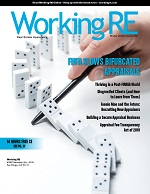 |
“One of the best courses that I have had in 17 years!” -Amy H
>> OREP E&O |
OREP/WRE Coronavirus Appraiser Blog
Coronavirus Appraiser Survey
Upgrade Your Appraisal Skills:
Six Part Coursework from OREP Education
$59 (Free to OREP Members)
Appraising During a Pandemic
By Isaac Peck, Editor
Appraisers today find themselves in unprecedented, dangerous times.
As the “eyes and ears” of the lender, the majority of appraisal assignments have traditionally required both an interior and exterior inspection of the subject property, often with a talkative (sometimes pushy) homeowner trailing close behind. But since the outbreak of the COVID-19 pandemic, the interior inspection has morphed from a routine facet of the appraisal process into a gauntlet that places appraisers, their loved ones, and even the property’s occupants in harm’s way.
The irony of this crisis, of course, is that despite the relentless push by the lending community to minimize and replace appraisers via automated valuation models (AVMs) and bifurcated appraisals, when the rubber meets the road with COVID-19, lenders and regulators continue to insist on interior appraisal inspections, never mind doing away with appraisals entirely. And it’s appraisers who are objecting to the completing interior inspections.
Even though the Government Sponsored Entities (GSEs) as well as agencies like the USDA and HUD/FHA now allow for exterior-only and desktop appraisals, in lieu of a traditional interior-inspection appraisal, interior inspection appraisals are still the “preferred” valuation method in this pandemic (See FHFA Directive on Interior Appraisals for more ).
More than being preferred, interior inspections are being required for a number of loan types and scenarios across the lending spectrum, over the objections of many appraisers who resent having to choose between feeding their family or putting their family at risk: many wonder why the 2055 desktop appraisal is not good enough during this crisis. Perhaps there’s a silver lining in the message this sends about the value of the appraiser’s role, however disagreeable and reckless some may believe it to be in the present moment.
Here’s a snapshot of the challenges faced by appraisers and the valuation industry as a whole.
Lender Preference
Despite flexibilities that allow for alternative appraisal methods, initial reports indicate that many lenders are continuing to pursue full 1004 appraisals, including the interior inspection. That’s the good news and the bad news.
Michael Tedesco, Chief Executive Officer of Appraisal Nation, a national Appraisal Management Company (AMC), confirms that many of his clients prefer to receive an interior inspection appraisal report, even if the GSEs will accept a lesser product. Fannie and Freddie’s guidelines say to get a traditional interior inspection appraisal if available, so in many cases we’re ordering an interior inspection appraisal as the first order of business. Of course it is location specific. In New Jersey or New York, I don’t think anyone should be doing interior inspections, but in places like North Carolina where we’re headquartered, there is less risk because the number of cases aren’t as high,” says Tedesco.
Appraisal Nation also has a number of private lender clients that hold loans in their own portfolio, and Tedesco reports those clients are much less inclined to accept an exterior-only or desktop in lieu of an interior inspection report. Tedesco says his firm has a procedure in place if an appraiser has concerns related to COVID-19. “If the appraiser accepts an order and doesn’t feel safe, we will go back to the lender and see if an exterior-only is acceptable, if it falls within the guidelines. We also have a questionnaire that goes to homeowners where we ask questions about the health of the occupants, if any of those questions indicate illness, we’re not going to go into that property,” says Tedesco.
Currently, Tedesco says that less than 25 percent of his firm’s orders are exterior-only or desktops, but he sees that potentially increasing as time goes along.
Cash-Out Refinances
Complicating matters further is the fact that both Fannie Mae and Freddie Mac require a traditional interior-inspection appraisal for cash-out refinances, which are quickly becoming a significant segment of the mortgage market. While cash-out refinances represented just a small fraction of the mortgage market as recently as a few years ago, Freddie Mac’s Quarterly Refinance Report (March 13, 2020), indicates that “cash-out” borrowers—those who increase their loan balance by at least five percent, represented 83 percent of all conventional refinance loans. Freddie writes that this is the “the highest share since the third quarter of 2007.”
John Smith (name changed for privacy), a Chief Appraiser at a regional AMC, says that the result has been very little relief on interior inspections for refinance transactions. “When Fannie and Freddie came out with their announcement last month, we had a lender who had 600 refinance transactions in their pipeline. Out of those 600 transactions, we determined that 463 still needed interior inspections. You might disagree with it but cash-out refinancing is an American tradition. The market needs cash out refis,” says Smith.
In terms of why Fannie and Freddie are not allowing exterior-only and desktop products on cash-out refinances, Smith believes that it comes down to risk. “A lot of the purchase transactions are eligible for an exterior-only or desktop product. With purchase transactions, you’ve got a Realtor® who did a competitive analysis, a buyer looking at other homes and selecting the subject, negotiating the price, lots of MLS photos, etc. You’ve also got market exposure and the principle of competition. So I think the GSEs are thinking that they’re taking less risk with purchase transactions than with cash-out refinances. Not that the purchase price always equals market value, but on a refinance it can be a complete crapshoot,” says Smith.
Deciding Not to Inspect
Like so many other appraisers, Thomas Peevler, a Certified General appraiser in Prescott, Ariz. with more than 33 years of appraisal experience, made his decision to forgo interior inspections mid-March after the first few cases of Coronavirus in his area started to become public. But what got him thinking about it was a call with a borrower. “I had a conversation about COVID-19 with an older woman who was trying to refinance her home. She told me that she was older and has a history of respiratory issues. It really got me thinking! I’m 73 and also have a history of respiratory issues, and I don’t know that I’d be comfortable going into her house or anybody else’s for that matter,” says Peevler.
Since then, Peevler has declined all orders that include an interior inspection, which has been every order that has come his way to-date. Peevler says he still has the woman’s file on his desk and he told her that he would wait to hear from the lender to see if they would allow an exterior-only valuation. So far, he says the lender hasn’t contacted him again, suggesting that they may prefer to forgo the woman’s business rather than accepting less than a full appraisal on her property.
Peevler says that since the GSEs issued their temporary guidance on March 23, he has continued to receive from six to eight traditional interior-inspection 1004 orders every day from his clients as of this writing (mid-April). “In the last few days I have received 15–20 orders from my AMC clients and I have turned down every single one of them. Some of my clients are a little unhappy with me for not accepting the new assignments, but none of the orders have been desktops or exterior-only assignments,” says Peevler.
In a comment left on OREP/Working RE’s Coronavirus (COVID-19) Appraiser’s Discussion and Resource Page (March 20), appraiser Richard Hurtig expresses what many appraisers are likely feeling when faced with the choice of doing interior-inspections or being unable to provide for their families: “Like everyone here I have been put in the impossible position of having to choose between the health and safety of myself and my family and maintaining my livelihood. It is absolutely insane that we are being asked to perform interior inspections in the middle of a worldwide pandemic. I can’t afford not to work so I am taking every precaution I can: pre-inspection screening of homeowners, mask, gloves and sanitizer. I don’t even enter my house with the clothes I was wearing in the field, changing in the garage, washing them immediately and showering as soon as I get back from the field. Any one of us can be exposed in one property and then spread the virus to every other home we enter, which could literally kill someone, not to mention ourselves or someone in our family.” (Click Here to read what appraisers are saying and join the discussion.)
Gathering Data for Exterior-Only
For those appraisers who are performing exterior-only and desktop assignments in lieu of traditional interior-inspection assignments, a number of creative methods are being used to gather information from the homeowner or real estate contact. Some appraisers are using FaceTime to do a real-time walkthrough of the property with the property occupant so they can still observe the interior of the property. Appraisers are also interviewing the homeowner and using those interview notes to make a determination about the property condition. In many cases, such practices are being encouraged by the appraiser’s clients.
To help appraisers gather critical information without entering the property, real estate technology company Clear Capital has launched OwnerInsight, a new homeowner-enabled appraisal inspection tool. The no-cost tool allows the home’s occupant to transmit information about the home as well as high-quality and images of the interior and exterior of their homes to the appraiser.
The appraiser has the ability to send a text message or email to the home occupant or real estate contact, inviting them to use the web-based application. The home occupant is then guided through questions about the property and given clear photo prompts to ensure complete and accurate results. Once complete, the report is immediately delivered back to the appraiser. The tool can also be used by AMCs and lenders. “OwnerInsight provides critical efficiencies for lenders and appraisers to access information that is indispensable to the appraisal process, especially during COVID-19,” says Jeff Allen, executive vice president of valuation strategy at Clear Capital. “OwnerInsight helps homeowners and appraisers avoid a cumbersome and confusing back-and-forth, trapped in email and phone calls with unclear requirements and no fraud mitigation.”
Bradford Technologies developed its own homeowner property collection tool called Onsight™, free to the industry until June 1, 2020. The tool guides the homeowner step-by-step through the information and photo collection process. The idea of using these new applications is that the more information the appraiser gathers and analyzes, even if delivered by a homeowner, the more accurate the appraisal will be. In other words, by going beyond the minimal requirements of a simple exterior-only or desktop assignment, the appraiser can develop a more credible value opinion.
Appraiser Diagnosed with COVID-19
The reality of our collective circumstances hits especially close to home when we hear that one of our own, a fellow appraiser, contracted the virus. Bryan Reynolds, a popular national appraisal instructor, owner of Fine Point Valuations, and a Partner at Appraiser eLearning, revealed via LinkedIn that he had been hospitalized with the Coronavirus and had just been released. In an emotional six-minute video, Reynolds thanked everyone who showed him support through his recovery. Reynolds revealed that he had been quarantined alone in a hospital room, adding that he wasn’t really alone as God was watching over him, and then thanked God for his recovery.
Reynolds urged everyone to be careful, saying “it doesn’t affect some people as much as others, but it can affect some people greatly.” Reynolds revealed another gentleman who was checked in at the hospital at the same time passed away from the virus. “My heart and prayers go out to his family; I don’t even know him.”
Reynolds revealed that his daughter was also sick and is on the mend. “I promise you, you probably know someone who has been impacted by this and it’s very, very serious. So please take it seriously and do your part,” says Reynolds.
Survey Results
At the time of this writing, the OREP/ Working RE survey—Coronavirus: State of the Appraisal Industry, had over 1,800 responses from appraisers around the country. Nearly 40 percent indicate that they have stopped performing interior appraisal inspections because of the Coronavirus pandemic, with 60 percent reporting that they are still performing interior inspections while taking precautions.
Based on the survey data, it appears that many lenders have already begun allowing alternative appraisals, with the majority of appraisers, 55 percent, reporting that at least some of their lender clients are now allowing desktop or exterior-only appraisals in lieu of traditional interior-inspection appraisals. That leaves roughly 45 percent of appraisers, like Peevler, who report that their clients are still ordering interior-inspection assignments, with no allowance for alternative products.
With the situation rapidly developing, the adoption rate of interior-inspection alternatives is likely to increase, but will vary widely across the country depending on how many appraisers are willing to do them, along with the severity of the Coronavirus outbreak in a given locality, state laws, and even the willingness of the homeowners to allow an appraiser onto the property.
Looking Ahead
The guidelines issued by the GSEs and other government departments like HUD/FHA stipulate that the allowance for alternative products in lieu of an “interior inspection” appraisal has been extended to June 30, 2020. However, it remains uncertain whether appraisers will be able to return to business as usual by the end of June. Predicting the future is impossible, now more than ever, but it’s likely that challenging times are ahead.
So far, the data shows that even in the face of a deadly pandemic, traditional “interior inspection” appraisals continue to be required in a variety of circumstances by the “powers that be,” and many lenders continue to pursue them even when an alternative report may be acceptable. In the meantime, many appraisers are still working, being very careful about the interior inspections they accept and trying to gather as much information as possible when performing exterior-only or desktop assignments.
Appraisals are an “essential service,” after all. But what a bittersweet message that is, given the risks involved. Stay safe out there.
Sidebar: Appraisals Are Essential Services
At press time, nearly 40 states have passed Stay-at-Home orders, with many of those orders exempting appraisal services and/or declaring them “Essential Services.” Bill Garber, Director of Government and External Relations at the Appraisal Institute, shared a State by State Report that outlines how appraisal services are classified for most states that have issued State-at-Home orders as of late March. (Click Here to read the report.) The majority of states provide an exemption for appraisal services.
Several states, California included, cite Homeland Security/Cybersecurity and Infrastructure Security Agency’s (CISA) list of 16 Critical Infrastructure Sectors (Click Here for a full list). On March 29, CISA published a FAQ titled “Guidance on the Essential Critical Infrastructure Workforce” that confirmed “Residential and commercial real estate services, including settlement services” are essential services. Currently three states, PA, NJ, and VT, have asked appraisers not to do interior inspections under any circumstances.
>> Six Part Appraiser Coursework from OREP Education
Register: $59 (Free to OREP Members)
Don’t Miss Tomorrow’s Course (Part 5 of 6):
How a Regression Analysis Can Help
Determine Adjustments
“This was my first time to listen to one of Richard Hagar’s courses and I wish I had done so much sooner! Very valuable info and easy to understand. Thank you very much for providing this free tool as part of my OREP membership!” -RM
>> Join the Discussion at OREP/Working RE’s Coronavirus (COVID-19) Discussion and Resource Page/a> where you can share your thoughts, experiences, advice and challenges with fellow appraisers.
>> Take OREP/Working RE’s Coronavirus: State of the Appraisal Industry survey here.
About the Author
Isaac Peck is the Editor of Working RE magazine and the Vice President of Marketing and Operations at OREP.org, a leading provider of E&O insurance for appraisers, inspectors and other real estate professionals in 50 states. He received his master’s degree in accounting at San Diego State University. He can be contacted at isaac@orep.org or (888) 347-5273.
CE Online – 7 Hours (AQB Approved)
Identifying and Correcting Persistent Appraisal Failures
Richard Hagar, SRA, is an educator, author and owner of a busy appraisal office in the state of Washington. Hagar now offers his legendary adjustments course for CE credit in over 40 states through OREPEducation.org. The new 7-hour online CE course Identifying and Correcting Persistent Appraisal Failures shows appraisers how to avoid CU’s red flags, minimize callbacks, save time, and earn more! Learn how to improve the quality of your reports and build defensible reports! OREP insureds save on this approved coursework. Sign up today at www.OREPEducation.org.
Sign Up Now! $119 (7 Hrs)
OREP Insured’s Price: $99
>Opt-In to Working RE Newsletters
>Shop Appraiser Insurance
>Shop Real Estate Agent
Insurance
Send your story submission/idea to the Editor:
isaac@orep.org





by David
Don’t you find it abhorrent that the lenders said that they understood our decision to not do interior inspections then continued to push them and find replacements that would do interiors while they locked their own doors (til June 1st.) and decided to work from home.
-by DANIEL SPLENDIDO
Do what is best for yourself and your health. It should be obvious by now that AMCs, Lenders, and GSEs don’t give a god damn about you.
-